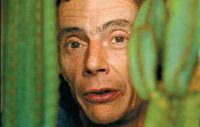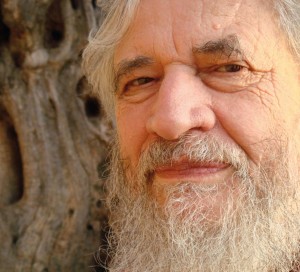Ayahuasca is made from the stem of the ayahuasca vine (Banisteriopsis caapi), almost always combined with the leaves of one or more of three compañeros, companion plants — the shrub chacruna (Psychotria viridis), the closely related shrub sameruca (Psychotria carthaginensis), or a vine variously called ocoyagé, chalipanga, chagraponga, and huambisa (Diplopterys cabrerana). It is in fact the companion plant that contains the potent hallucinogen dimethyltryptamine (DMT); but, while DMT is effective when administered parenterally, it is, when taken orally, inactivated by peripheral monoamine oxidase-A (MAO-A), an enzyme found in the lining of the stomach, whose function is precisely to oxidize molecules containing an NH2 amine group, like DMT.
The ayahuasca vine contains three primary harmala alkaloids — the β-carboline derivatives harmine, tetrahydroharmine (THH), and harmaline. Harmine is the primary constituent, followed first by THH and then by harmaline. These three harmala alkaloids are potent reversible inhibitors of MAO-A. Thus, combining the ingredients of the ayahuasca drink allows the DMT to produce its hallucinogenic effect when orally ingested — a unique solution which apparently developed only in the Upper Amazon. Indeed, the MAO-inhibiting β-carbolines in the ayahuasca vine may also potentiate the actions of psychoactive alkaloids other than DMT — for example, nicotine from mapacho (Nicotiana rustica), or the primary tropane alkaloids from toé (Brugmansia spp.).
The question is: Apart from inhibiting MAO, do these β-carbolines contribute to the nature or quality of the ayahuasca visionary experience?
 |
| Alexander Shulgin |
The accepted wisdom answers no. A study of the ayahuasca drink used by the syncretic religious movement União de Vegetal in Brazil, for example, concluded that the harmala alkaloids “are essentially devoid of psychedelic activity” at doses found in the drink.
A number of experiments with harmine — the primary β-carboline in the ayahuasca vine — would seem to bear out this assessment. The chemist Alexander Shulgin has reviewed the self-experimentation literature and concluded that harmine has inconsistent effects, which have in common that not much either pleasant or interesting happens — pleasant relaxation and withdrawal in one case; dizziness, nausea, and ataxia in another. Researchers who have self-administered harmine have reported an increase in belligerence, fleeting sensations of lightness, transient subjective effects, mild sedation at low doses and unpleasant neurological effects at higher doses, and, indeed, no “notable psychoactive or somatic effect.” Some researchers have expressed doubts that harmine is psychoactive at all.
Jonathan Ott gives several accounts of his own experiences with ingesting infusions of the ayahuasca vine or other β-carboline-rich plants without DMT additive plants. During one shamanic ceremony, he drank an infusion of the ayahuasca vine mixed only with a small number of guayusa (Ilex guayusa) leaves, which contain caffeine but no tryptamines, which he intended to counteract the soporific effects of the drink. According to Ott, the caffeine content was insufficient for that purpose; he had to fight off sleep. He could see, he writes, why β-carboline-enriched infusions had been used traditionally as sedatives.
 |
| Jonathan Ott |
However, there are two reasons to question the common wisdom. The first is the work of Claudio Naranjo, who administered harmaline — not harmine — to 35 volunteers, by mouth and intravenously, under laboratory conditions. Harmaline, he reports, was “more of a pure hallucinogen” than other psychoactive substances, such as mescaline, because of the number of images reported and their realistic quality — what Naranjo calls their “remarkable vividness.” “In fact,” he writes, “some subjects felt that certain scenes they saw had really happened, and that they had been disembodied witnesses of them in a different time and place.” The volunteers often described landscapes and cities, masks, eyes, and what are elsewhere called elves — vividly realized animal and human figures, angels, demons, giants, dwarfs. If this study is credible, there are grounds to believe that, among the β-carbolines, at least harmaline, at sufficient doses, has independent hallucinogenic properties, phenomenologically not dissimilar to those of DMT.
Shulgin’s review of the self-experimental literature with regard to harmaline provides some confirmation of the reports of Naranjo’s volunteers. A 500-mg oral dose produced nausea and a complete collapse of motor coordination — “I could barely stagger to the bathroom,” one person reports — along with eyes-closed eidetic imagery, and “tracers and weird visual ripplings” with open eyes. It is even more interesting to look at the effects of Syrian rue (Peganum harmala), which contains pretty much equal quantities of harmine and harmaline, as opposed to the proportionally much smaller amount of harmaline in the ayahuasca vine. Oral ingestion of ground Syrian rue seeds caused intense eyes-closed hallucinations of “a wide variety of geometrical patterns in dark colors,” which evolved into more concrete images — “people’s faces, movies of all sorts playing at high speeds, and animal presences such as snakes.” Oral ingestion of a fivefold greater dose, as extract, caused “zebra-like stripes of light and dark” — visual effects which had “a physicality unlike those of any other entheogen I’d experienced.” In a second trial at the same dose, the participant saw “strange winged creatures” and traveled to “jungle-like places, full of imagery of vines, fountains, and animals.”
 |
| Claudio Naranjo |
Now, the amount of harmaline in any sample of ayahuasca vine or drink is extremely variable; it is a matter of controversy whether any infusion of the ayahuasca vine contains enough harmaline to cause the effects reported above. Jonathon Ott, whose views deserve respectful attention, says that the amount of harmaline in a single 200-ml drink of ayahuasca would be insufficient to produce the effects reported by Naranjo.
Yet the accepted wisdom is challenged by ethnography as well. Among mestizo shamans, an ayahuasca drink made solely from the vine is sometimes ingested orally for hallucinogenic effects of a particular “dark” nature. In addition, ayahuasqueros, virtually universally, say that it is the ayahuasca vine that provides the fuerza, the power, and DMT-rich plants such as chacruna that provide the luz, the light, in the ayahuasca experience. In Colombia, the shamans say that the companion plant brilla la pinta, makes the visions brighter; among the Shuar, the companion plant is not considered to have any hallucinogenic effects, but rather is believed to make the visions clearer, and is in fact occasionally omitted. The great ethnobotanist Richard Evans Schultes reports that certain Colombian Indians smoke leaves of the ayahuasca vine; under certain circumstances, my teacher don Roberto Acho recommends the smoking of the bark.
Schultes himself, at Puerto Limón, drank an infusion derived solely from ayahuasca bark: the visions he experienced were blue and purple, he reports — slow undulating waves of color. Then a few days later he tried the mixture with chagraponga. The effect was electric — “reds and golds dazzling in diamonds that turned like dancers on the tips of distant highways.” As my teacher don Rómulo Magin told me, visions with the ayahuasca vine alone are dark and dim; the chacruna makes the vision come on like this: whoosh! he said, moving his closed hand rapidly towards my face, the fingers opening up as it approached. Luis Eduardo Luna, one of the leading investigators of Amazonian mestizo shamanism, reports that often a larger amount of the ayahuasca vine is added to the ayahuasca drink than is needed for MAO inhibition, precisely because of its ability to produce strong visual hallucinations.
There is also some reason to believe that THH may have some role in the hallucinogenic effects of the ayahuasca vine, either by itself or acting synergistically with other β-carboline compounds. Indeed, in 1957 Hochstein and Paradies had already conjectured — “astutely,” in the words of Jonathon Ott — that harmaline and THH might have “substantial psychotomimetic activity in their own right.” Strikingly, among members of the ayahuasca-using União de Vegetal church in Brazil, experienced users seem to prefer ayahuasca drinks where THH concentrations are high relative to harmine and harmaline. They explain that such drinks deliver more “force” to the experience. It is therefore surprising that so little research has been done on THH. Alexander Shulgin, in his search of the self-experimentation literature, found only a single and entirely unhelpful report. “More studies on tetrahydroharmine,” he says, “are absolutely imperative.”
Similarly, additive and — especially — synergistic studies of harmala alkaloids have not been performed. The ethnographic evidence strongly suggests that interactive effects are important and are yet to be investigated.

- Previous Post: The War on Drugs
- Next Post: Sasha Redux
- More Articles Related to: Ayahuasca, Sacred Plants



I’ve done a session with a palero curandero who never mixes DMT plants to ayahuasca. I had dark visuals but other people reported clear trips around the world.
REM: He said DMT plants does not contribute to the healing effects of
ayahuasca, and visions were stronger and within context with vine only.
I tried pure harmaline and had some “dark” visions as mentioned. Also in “ibogaine story” book it is mentioned that ibogaine and harmaline are very similiar molecules and have similiarities in function. In a way ibogaine is described as harmaline which does not need DMT type “brighteners”. At least that’s what I understood. So harmaline type beta-carbolines should be the main “medicine” although we sometimes falsely think that it is only for MAO inhibition.
ive had a half gram of THH taken orally, in addition to later ingesting chaliponga and cielo caapi with calea zacatechichi. the THH caused extreme ghost tracers and shutter like perception almost like glitching, i felt separation between my body and me, my body could barely hold me and i did not notice my body falling as i walked to the bathroom.
we need more THH work
In 1976 I obtained a quantity of harmaline hydrochloride add conducted a series of weekly “tastings”, starting at very low doses and working up. At 200mg I felt definite but vague effects. The next dose, according to my dosage plan, should have been 250mg but, feeling that it still might not be enough for the full effects, I took all of the remaining material: 450mg. (Yes, young, foolish, etc.)
The effects were quite remarkable. The lighting in my living room seemed to bright. Not only that but it made me feel physically heavy. When I turned the lights off and lit a single candle I felt a lot better – and light as a feather.
Following my standard tripping procedure, I put an LP on the turntable and lay down on the couch. Closed eye visions came thick and fast. And I do mean fast! Fully-formed 3D landscapes and interiors appeared in a flash and were replaced a second later by a completely different fully-formed scene. In one such momentary vision, I looked up from the floor of a room lined with books. There was no ceiling and floating down from a clear blue sky was man in top hat, cape and silver-handled cane. (Years later it dawned on me that he was Mandrake the Magician, hero of an old newspaper comic strip.)
Eventually, the LP reached its end and began the kshht-kshht-kshht sound familiar to us older folk. “Oh well,” I thought, “I’ll guess I have to get up,” and before I knew what had happened, I went vertically upwards and found myself standing with one foot on the cushions and the other on the back of the couch. (I said I felt light.) Feeling a bit wobbly, I didn’t trust myself to get down in the normal manner so I jumped into the middle of the room. I landed like thistle-down, so lightly that the record-player stylus didn’t skip.
I had a splitting headache next morning but thought that one day I’d like to try a small amount of harmaline as a “flavoring” with LSD. I never have, though.